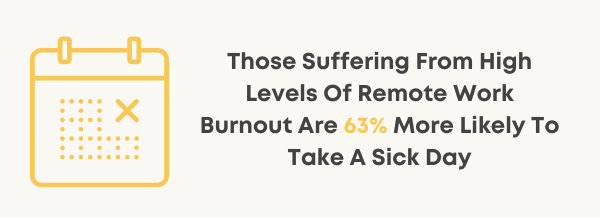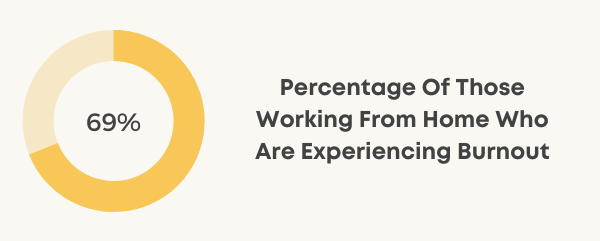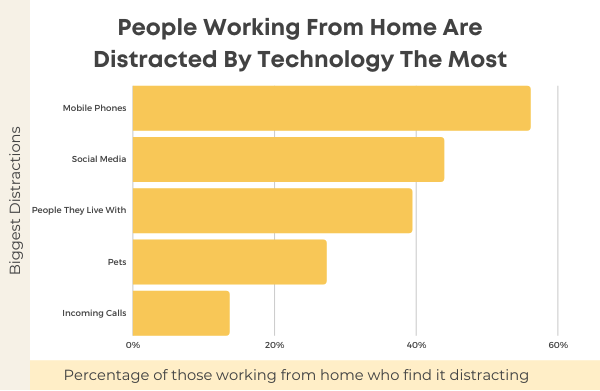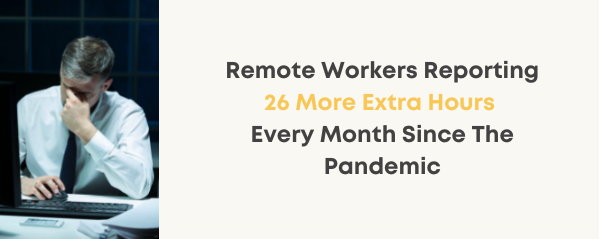Many of those who are working from are complaining about remote working burnout.
While remote work is still a major perk, the arrival of a global pandemic has caused remote workers to suffer from different health problems.
Burnout at work comes as a result of chronic workplace stress that has not been managed successfully.
Are remote workers more burnt out now than they were before the start of the pandemic? Are companies doing enough to avoid or treat work burnout?
To find out more, read our list of shocking remote work burnout statistics. Let’s get going!
Editor’s Pick Of Remote Work Burnout Statistics
- 75% of workers say they have experienced burnout at work.
- 69% of remote workers report suffering from burnout during COVID.
- 59% of remote workers are taking less time off work than normal.
- Remote workers have worked 26 more extra hours every month.
- 56% of remote workers are distracted by mobile phones.
15 Remote Work Burnout Statistics
1. The number of workers who report stress from working from home has risen to 18% during the pandemic.
When workers experience burnout, their mental and physical health starts suffering, as well. This is the same for those experiencing remote working burnout. While only 5% suffered from this kind of remote work stress before the pandemic, it has more than tripled since then.
Source: FlexJobs
2. While 75% report they have experienced burnout at work, 40% say it was during the pandemic.
While working from home, employees have to deal with job tasks, childcare, and many other responsibilities all. More than that, employees have also been working longer hours at home which possibly resulted in burnout.
Source: FlexJobs
3. Those who experience high levels of burnout are 63% more likely to take a sick day off work.
Apart from taking sick days off work, these workers are also 23% more likely to need to see a doctor and 13% less confident in their work performance.
Source: Gallup


4. Before the pandemic, those who worked remotely felt less burnout than they did during the pandemic.
During the pandemic, 29% of those working from home full-time have felt burnt out. In comparison, 18% of them felt burnout before COVID-19. Likewise, before the start of the pandemic, remote workers felt less burnout than those working on-site full-time.
Source: Gallup
5. 69% of employees working from home are experiencing burnout.
More than two-thirds of employers are experiencing higher or lower levels of burnout, according to a Monster study. Moreover, employees are continuing to overwork without taking time off to recharge, as they fear they could be the next ones to go if they do not make effort.
Source: Monster


6. Despite working from home, 59% of them are taking less time off than they would normally.
This majorly contributes to feeling burnt out, as time off work is necessary to recharge and feel better mentally and physically. Moreover, the same remote work burnout statistics also show that 42% of them are not planning to take time off work anytime soon.
Source: Monster
7. 65% of remote workers are working longer than they did when they worked in the office.
Working longer and longer every day while being stuck at home due to the pandemic surely affects the health of workers. That is why it is not at all surprising that remote work is causing burnout, as 6 in 10 are working longer hours from home than they did in the office.
Source: FlexJobs
8. The biggest distraction for those working from home is mobile phones (56.1%).
For 56.1% of people who are working from home the biggest distraction during office hours is mobile phones. Apart from that social media is also a big distraction for 43.9% of them. Out of social media they use, 65.5% use Facebook, 51.7% Instagram, 48.3% Youtube, and so on.
Source: OfficeNeedle


9. The biggest struggle for those working remotely is the difficulty to unplug after work (27%).
For 27% of remote workers, it is a struggle to unplug after work, which may as well lead to burnout. Loneliness and difficulty collaborating share the second place of struggles at 16%, 15% struggle with distractions at work, and 12% struggle with staying motivated.
Source: Buffer
10. 84% of millennials working from home report feeling remote work burnout.
The majority of workers belong to the millennial generation, and they are also experiencing a lot of burnout while working from home. Besides feeling burnout, this can also lead to higher levels of stress and anxiety, according to remote work mental health statistics.
Source: Deloitte
11. Remote workers have worked 26 more extra hours every month since the pandemic started.
Now if this does not scream burnout, we don’t know what does. Overworking leads to burnout, as remote workers work longer hours month after month while in lockdown. As it is hard for them to set boundaries between work and other aspects of life, they usually end up feeling burnt out.
Source: Owl Labs


12. Compared to pre-pandemic, 45% of remote workers are now working more hours, including weekends.
Remote workers are now working more hours than before the pandemic according to the Robert Half survey. Moreover, parents who work remotely are more like to work longer than 8 hours a day, as well as weekends, compared to those without children.
Source: Robert Half
13. 70% of employees feel their employers are not doing enough to minimize burnout.
Moreover, 21% of workers say that their employer offers no program for preventing or aiding burnout in the organization or company.
Source: Deloitte


14. Workplace burnout costs companies $190 billion in medical expenses per year.
Companies suffer financially from workplace burnout, too. It is estimated that they spend $190 billion on medical expenses annually just from workplace burnout.
Source: Stanford
15. 41% of remote workers are reporting high levels of stress.
Compared to that, only one quarter (25%) of office workers are also reporting high levels of stress.
Source: UN
Final Verdict
While work from home used to be a big perk before the pandemic, remote workers have suffered from burnout since the pandemic started. These remote work burnout statistics are telling us that both employees and employers need to do more so that remote work can become a perk again, and not result in high levels of stress and burnout. If you are interested in remote work statistics, you can learn more about them, as well.


































Find Us on Socials